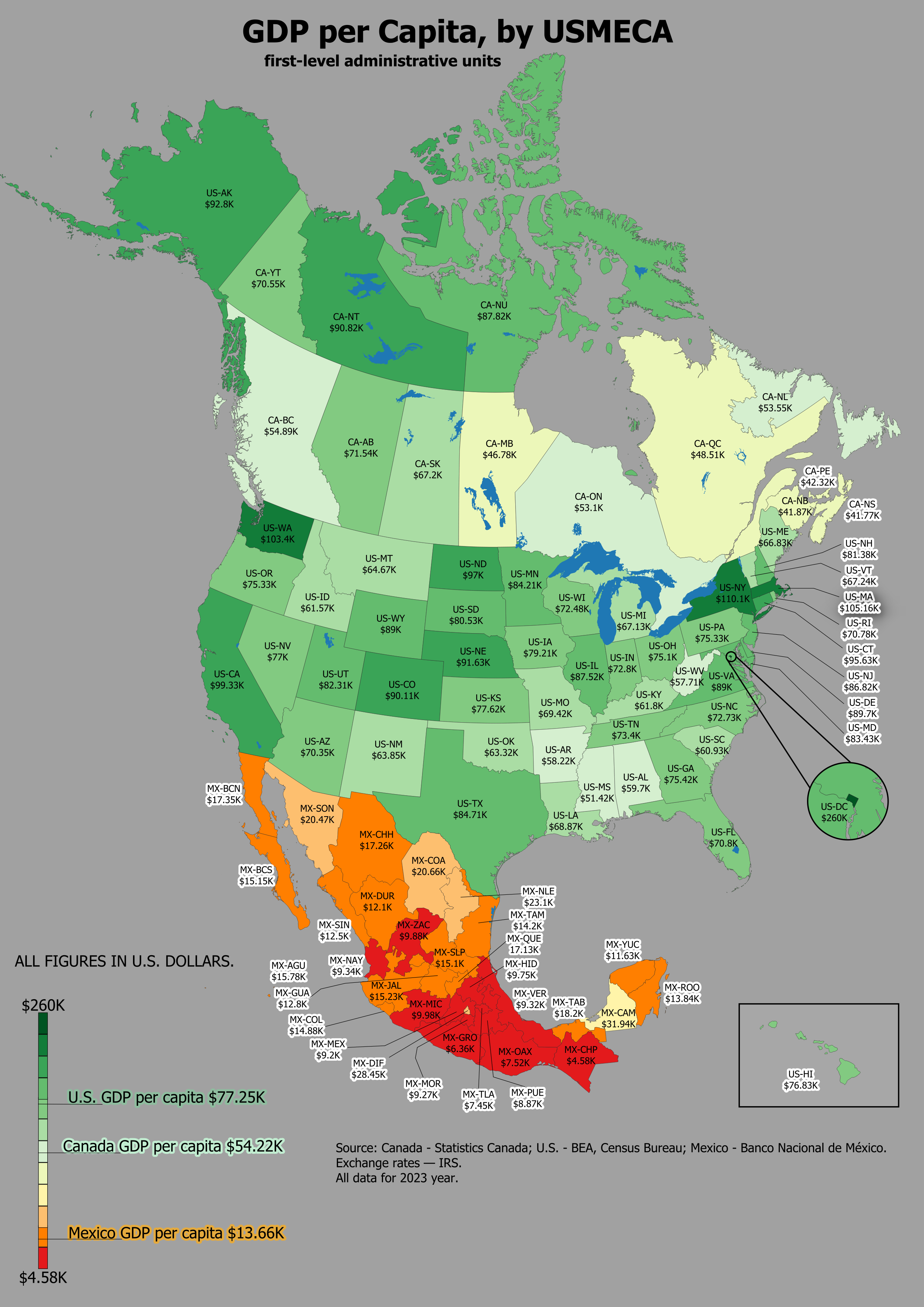GDP Per Capita by USMECA Map


David Chen
Data Visualization Specialist
David Chen is an expert in transforming complex geographic datasets into compelling visual narratives. He combines his background in computer science ...
Geographic Analysis
What This Map Shows
The visualization titled 'GDP per Capita, by USMECA first-level administrative units, 2023' highlights the economic performance of regions within the USMECA grouping—comprising the United States, Mexico, and Central America—through a detailed depiction of GDP per capita across various administrative units. GDP per capita is a critical indicator that measures the average economic output per person, providing insight into the standard of living and economic health of different areas. This map serves as a useful tool for visualizing economic disparities and growth across these countries in 2023.
Deep Dive into GDP Per Capita
GDP per capita is an essential metric in understanding economic performance, as it can reveal much about the prosperity of a region and the well-being of its inhabitants. By dividing the gross domestic product (GDP) of a region by its population, we get a per-person measure that helps in comparing the wealth of different areas. Interestingly, GDP per capita can also reflect structural economic factors, including industry composition, labor force participation rates, and investment in education and infrastructure.
For instance, in 2023, the United States continues to show a significantly higher GDP per capita compared to its neighbors. This is largely due to its diverse economy, which includes advanced technology, finance, and manufacturing sectors. In contrast, many Central American countries, while rich in natural resources and cultural heritage, face challenges such as political instability and limited access to education, which can hinder their economic growth. Countries like El Salvador and Honduras have comparatively lower GDP per capita, emphasizing the ongoing struggle for economic development in the region.
What’s fascinating is that GDP per capita doesn't just reflect current economic conditions but also indicates potential future trends. Regions with high GDP per capita often attract foreign investment, leading to improved infrastructure and job opportunities, which can further elevate the standard of living. Conversely, stagnant or declining GDP per capita can result in economic decline, emigration, and increased poverty levels.
Regional Analysis
When analyzing the map, we can see stark contrasts in GDP per capita across the USMECA regions. For example, states such as California and New York in the United States report some of the highest figures, often exceeding $70,000 per capita. These states benefit from strong technological and financial sectors, which create wealth and attract talent.
On the other hand, Mexican states like Guerrero and Chiapas show much lower GDP per capita figures, around $10,000 to $15,000. These areas often rely heavily on agriculture and tourism, which may not generate as much economic output per person as urbanized, industrialized areas. In Central America, countries like Nicaragua and Guatemala also experience lower per capita GDP, often under $5,000, reflecting challenges such as limited industrialization and economic diversification.
Interestingly, there are regions within each country that defy these general trends. For instance, some urban areas in Mexico, like Mexico City, exhibit much higher GDP per capita than rural areas, thanks to their concentration of services, education, and infrastructure. Similarly, urban centers in Central America, such as San Salvador, can have GDP figures significantly higher than their national averages, hinting at the importance of urbanization in economic development.
Significance and Impact
Understanding GDP per capita and its implications is crucial for policymakers, economists, and citizens alike. It informs us not just of current economic health but also shapes discussions around social policies, education, and investment. Regions with lower GDP per capita may require targeted interventions, such as improved access to education and healthcare, to elevate their economic standing and enhance quality of life.
Moreover, the disparities highlighted by this map remind us of the broader global economic landscape. The ongoing trends suggest that countries and regions must adapt to changing economic conditions, technological advancements, and global market dynamics. As we move forward, keeping an eye on GDP per capita trends will be essential for anticipating future economic shifts and making informed decisions that could benefit communities across the USMECA region. Ultimately, the map serves as a powerful reminder of the interconnectedness of our economies and the importance of striving for equitable growth across all regions.
Visualization Details
- Published
- August 19, 2025
- Views
- 110
Comments
Loading comments...